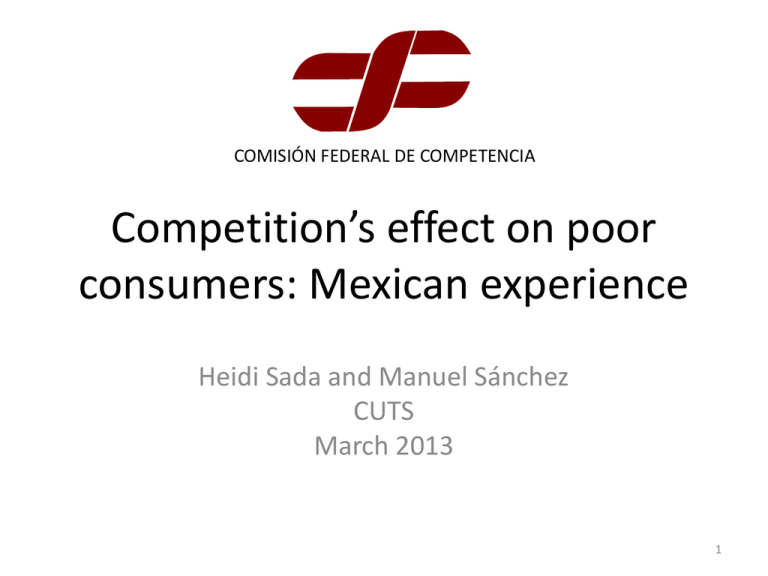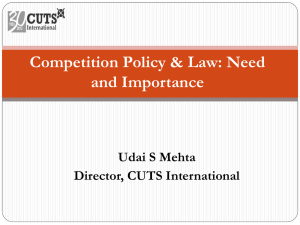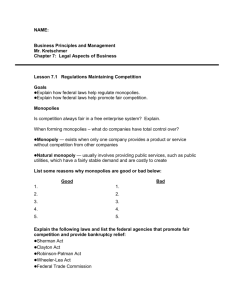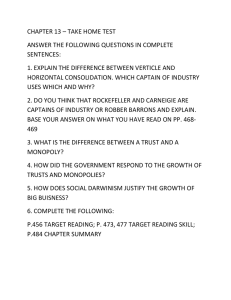Competition’s effect on poor consumers: Mexican experience Heidi Sada and Manuel Sánchez CUTS
advertisement

COMISIÓN FEDERAL DE COMPETENCIA Competition’s effect on poor consumers: Mexican experience Heidi Sada and Manuel Sánchez CUTS March 2013 1 Messages 1. Monopolies harm economic efficiency and could also worsen income distribution. 2. Mexico has many monopolized markets with negative effects on the poorest. 3. Competition policy could help reduce social inequality. 2 There is ample academic literature on the effects of monopolies on economic efficiency.… Evidence on effects of monopolies on efficiency Static effects Exorbitant profits and inefficient allocation of resources Dynamic effects Less incentives for productivity and innovation • Multiple studies that estimate that the lack of competition significantly increases prices. • Experiences in OECD countries show that when companies collude and form a cartel, the cost of goods and services can increase by 20% or more. • Empirical evidence suggest that the welfare loss associated with monopoly as a percentage of gross domestic product (GDP) varies between 0.1 to 13 per cent. • Vast evidence that more competition increases productivity and innovation. 3 … however, the distributive effects of monopolies have been less explored. The few studies identified suggest that monopolies can worsen social inequality: “… it appears that the presence of past and current monopoly has had a major impact on the degree of inequality in the current distribution of household wealth.” (Commandor & Smiley, 1975) “ Whatever the size of the absolute welfare loss arising from monopoly, there may be a substantial effect on the distribution of welfare” (Creedy & Dixon, 1998) 4 Messages 1. Monopolies harm economic efficiency and could also worsen income distribution. 2. Mexico has many monopolized markets with negative effects on the poorest. 3. Competition policy could help reduce social inequality. 5 In 2008, the CFC conducted a market study, supported by the OECD, to assess the distributive and spatial effects of monopoly power in the Mexican economy* Market identification: Basic consumer goods: Private monopolistic markets with direct effects on household spending 1. Corn tortillas 2. Processed meats 3. Chicken and eggs 4. Cow milk 5. Carbonated soft drinks, juices and bottled water 6. Beer 7. Pharmaceuticals * Carlos M. Urzúa (2008). “Evaluación de los efectos distributivos y espaciales de las empresas con poder de mercado en México”. The effects related to distribution of monopoly gains and consumer costs Static effects Possible distributive effects B + T = consumers’ welfare loss T = transference from the consumers to the firms (with monopolistic gains) B = net welfare loss • Monopolistic gains (T) could be distributed unevenly between income levels. pm T B pc Cmg qm Source: Carlos M. Urzúa (2008). • Consumers’ welfare loss (B+T) could vary among income levels. qc 7 Deadweight loss modeling Assumptions: Constant marginal cost (MC) c MC = Competitive price ( p ) ƞ is the price elasticity of the good (q m q c ) q m …………(i) m ( p pc ) pm Monopoly maximizes benefits when : pm pc 1 m p …………(ii) ( p m p c )( q c q m ) DWL 2 After combining (i) and (ii) in DWL: pmqm DWL 2 Assuming : •K Identical firms •Cournot conjectural response pmqm DWL 2K 8 Deadweight loss estimates (elasticities). pmqm 1 n wi DWL 2 K 2 i 1 Ki To estimate price elasticities Ursúa used a variation of the Deaton’s general model: 0 whc 0 0 ln xhc ln c f c u hc ln vhc 1 1 ln xhc ln c u1hc Variable whc Spending in the good as a share total expenditure of a household in cluster c vhc x hc Unitary value of the good regarding consumption oh a household in cluster c c Price of the good in cluster c Total income of a household in cluster c Fixed effect in cluster c fc u Description 0 hc ,u 1 hc Error terms Data source: National Survey on Household Income and Expenditure (ENIGH). Model source: Deaton, Angus. 1997. The analysis of household surveys: A microeconomic approach to development policy. Washington, World Bank. 9 The study results indicate that the loss of consumer welfare arising from monopolies is significant…. Consumer Welfare Loss Estimates % expenditure on the monopolized markets analyzed 41.9% 36.4% Urban Source: Carlos M. Urzúa (2008). Rural ….the negative impact of monopoly power grows as households are poorer. Welfare loss in poorest households 46.0% 39.4% 37.5% 32.9% I II III IV Source: Carlos M. Urzúa (2008). V VI Decile VII VIII Urban IX X Rural Monopolies deteriorate Mexican competitiveness, but also tend to worsen income distribution These variances can also be observed between Mexican states – with different levels of income Monopolies’ effects on welfare Bajo Medio Alto Source: Carlos M. Urzúa (2008). Messages 1. Monopolies harm economic efficiency and could also worsen income distribution. 2. Mexico has many monopolized markets with negative effects on the poorest. 3. Competition policy could help reduce social inequality. 13 Monopolies in Mexico have been linked to particular anticompetitive behavior, however, in many cases they depend on restrictions created by the government … By … • Imposing barriers to foreign trade • Implementing programs that facilitate collusion • Imposing subsidies that reduce o eliminate incentives to compete • Implementing strategies in public procurement that facilitate collusion and restrict entry (OECD- CFC joint work to tackle this) e.g. medicines, chicken & egg, corn tortilla 14





